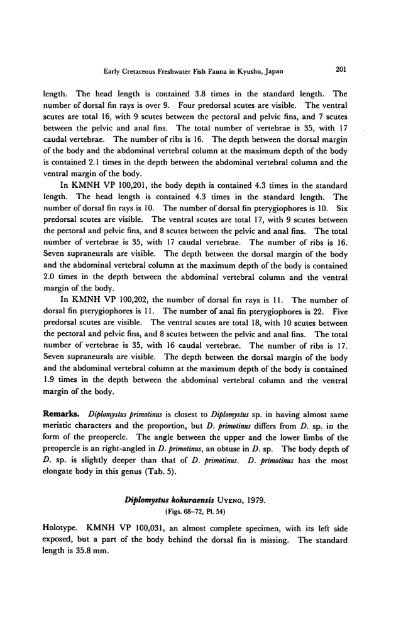Early Cretaceous Freshwater Fish Fauna in Kyushu, Japan
Early Cretaceous Freshwater Fish Fauna in Kyushu, Japan
Early Cretaceous Freshwater Fish Fauna in Kyushu, Japan
You also want an ePaper? Increase the reach of your titles
YUMPU automatically turns print PDFs into web optimized ePapers that Google loves.
<strong>Early</strong><strong>Cretaceous</strong> <strong>Freshwater</strong> <strong>Fish</strong> <strong>Fauna</strong> <strong>in</strong> <strong>Kyushu</strong>, <strong>Japan</strong><br />
^u*<br />
length. The head length is conta<strong>in</strong>ed 3.8 times <strong>in</strong> the standard length. The<br />
number of dorsal f<strong>in</strong> rays is over 9. Four predorsal scutes are visible. The ventral<br />
scutes are total 16, with 9 scutes between the pectoral and pelvic f<strong>in</strong>s, and 7 scutes<br />
between the pelvic and anal f<strong>in</strong>s. The total number of vertebrae is 35, with 17<br />
caudal vertebrae. The number of ribs is 16. The depth between the dorsal marg<strong>in</strong><br />
of the body and the abdom<strong>in</strong>al vertebral column at the maximum depth of the body<br />
is conta<strong>in</strong>ed 2.1 times <strong>in</strong> the depth between the abdom<strong>in</strong>al vertebral column and the<br />
ventral marg<strong>in</strong> of the body.<br />
In KMNH VP 100,201, the body depth is conta<strong>in</strong>ed 4.3 times <strong>in</strong> the standard<br />
length. The head length is conta<strong>in</strong>ed 4.3 times <strong>in</strong> the standard length. The<br />
number of dorsal f<strong>in</strong> rays is 10. The number of dorsal f<strong>in</strong> pterygiophores is 10. Six<br />
predorsal scutes are visible. The ventral scutes are total 17, with 9 scutes between<br />
the pectoral and pelvic f<strong>in</strong>s, and 8 scutes between the pelvic and anal f<strong>in</strong>s. The total<br />
number of vertebrae is 35, with 17 caudal vertebrae. The number of ribs is 16.<br />
Seven supraneurals are visible. The depth between the dorsal marg<strong>in</strong> of the body<br />
and the abdom<strong>in</strong>al vertebral column at the maximum depth of the body is conta<strong>in</strong>ed<br />
2.0 times <strong>in</strong> the depth between the abdom<strong>in</strong>al vertebral column and the ventral<br />
marg<strong>in</strong> of the body.<br />
In KMNH VP 100,202, the number of dorsal f<strong>in</strong> rays is 11. The number of<br />
dorsal f<strong>in</strong> pterygiophores is 11. The number of anal f<strong>in</strong> pterygiophores is 22. Five<br />
predorsal scutes are visible. The ventral scutes are total 18, with 10 scutes between<br />
the pectoral and pelvic f<strong>in</strong>s, and 8 scutes between the pelvic and anal f<strong>in</strong>s. The total<br />
number of vertebrae is 35, with 16 caudal vertebrae. The number of ribs is 17.<br />
Seven supraneurals are visible. The depth between the dorsal marg<strong>in</strong> of the body<br />
and the abdom<strong>in</strong>al vertebral column at the maximum depth of the body is conta<strong>in</strong>ed<br />
1.9 times <strong>in</strong> the depth between the abdom<strong>in</strong>al vertebral column and the ventral<br />
marg<strong>in</strong> of the body.<br />
Remarks. Diplomystus primot<strong>in</strong>us is closest to Diplomystus sp. <strong>in</strong> hav<strong>in</strong>g almost same<br />
meristic characters and the proportion, but D. primot<strong>in</strong>us differs from D. sp. <strong>in</strong> the<br />
form of the preopercle. The angle between the upper and the lower limbs of the<br />
preopercle is an right-angled <strong>in</strong> D. primot<strong>in</strong>us, an obtuse <strong>in</strong> D. sp. The body depth of<br />
D. sp. is slightly deeper than that of D. primot<strong>in</strong>us. D. primot<strong>in</strong>us has the most<br />
elongate body <strong>in</strong> this genus (Tab. 5).<br />
Diplomystus kokuraensis Uyeno, 1979.<br />
(Figs. 68-72, PI. 54)<br />
Holotype. KMNH VP 100,031, an almost complete specimen, with its left side<br />
exposed, but a part of the body beh<strong>in</strong>d the dorsal f<strong>in</strong> is miss<strong>in</strong>g. The standard<br />
length is 35.8 mm.

















